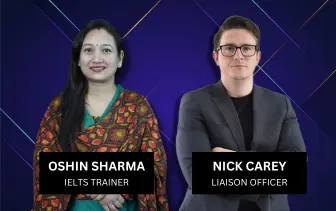
Meridean Overseas
Updated On 13 January 2024 & Read Time 9 minutes
3.3k
In the realm of IELTS speaking cue cards, there's one topic that never fails to spark excitement – “Talk about a Traditional Object of your country”. In this blog, we will provide 3 sample answers to the above topic. With the help of these answers, you can understand how to deal with these types of questions in the IELTS speaking cue card.
You will also get follow-up questions with answers for IELTS Speaking Part 3 in the blog, so read it vigilantly till the end.
Table of Contents
To live comfortably in the modern era, we rely heavily on readymade items produced in factories. However, there is something different about homemade products and edible items. I'd like to talk about a product I believe deserves mentioning.
It's a homemade churn for butter. When she was younger, my grandma purchased it. It is made of an earthen pot, a long wooden pole that functions as a blender, and a small moving rope.
My grandma always used it to create butter, as I mentioned before. I used it for the first time when I was around ten. It took a lot of physical strength, so I felt exhausted. Grandmother used it for approximately 15 to 20 minutes daily.
The only thing I enjoy doing with it is watching it; using it takes a lot of work. It was our grandmother's final memento. Therefore, my father kept it extremely safe in a glass box when she passed away because no one in our family was ready to use it.
Overall, this type of object has its own value, and people continue to use it as they did earlier.
Also, Read: IELTS Cue Card: Describe your Favorite Singer
Traditional things have historical significance and should be conserved; this object demonstrates our culture's relevance. It is our responsibility to pass on our culture to the next generation so that they can understand how people lived in the past. There are several kinds of pieces of jewellery that have been passed on for generations.
In this article, I will discuss a piece of jewellery that I was really drawn to at my cousin’s wedding. Bichiya is a ring of metal, mostly made of silver, that is worn on the indexed or middle toes. It’s like a ring for the toes. They are made of a plain string in various designs, and some feature metal balls that jangle. They are available in many styles and designs.
After knowing about this jewellery, I went to the market with my mother and saw this very pretty Bichiya. Then, I tried that bichiya and forced my mother to purchase it for my future.
After talking to my grandma, I learned the significance of Bichiya. In addition to representing a woman's married status, it was thought to be a device to press the toe points so that women could stay calm. It has surprised me to learn that, in contrast to our generation, jewellery was worn for purposes other than accessorising and making an outfit seem nice.
Although Bichiya doesn't feel any different, I particularly enjoy it as an accessory because it is stylish and complements many Indian and Indo-Western look, and who wouldn't want to get the benefits of wearing it?
Also, Read: IELTS Cue Card: Describe your First Day at School
Embark and excel in your study abroad journey with our expert team!

India has a diverse and distinct culture that has evolved over thousands of years and varies by location. Several of the main world faiths, including Buddhism, Hinduism, Jainism, and Sikhism, are said to have originated in India.
However, one thing you can find in most parts of my country, India, is Lehenga.’ It is one of the most revered and recognisable traditional objects in India. Lehenga is a three-piece ethnic wear, which includes a dupatta, blouse, and bottom wear.
A gorgeous article of clothing with elaborate patterns and vivid colours is the lehenga. It can be made from different types of clothing like georgette, silk, cotton, etc. It has been around for thousands of years and was mentioned in ancient literature. It's a representation of femininity and tradition rather than just a piece of clothing.
The lehenga’s significance in Indian culture cannot be overstated. It represents our illustrious ancestors. Generally, women wear this at several events, including festivals and weddings. It stands for grace and modesty. The different ways our rich culture is reflected in different locations.
I have a plethora of memories related to the Lehenga. I watched my grandmother and mother beautifully drape their Lehengas during every family function and festival. She would tell me tales about the meaning and background of each style; it was a ritual for her. I've loved lehengas since I was a small child, and I feel more connected to my heritage when I wear them.
All things considered, the lehenga is more than simply an article of apparel—it is a component of who we are. It represents our values, customs, and the beauty of our culture. It's a timeless emblem that holds a particular place in my heart and the hearts of millions of Indians.
Also, Read: IELTS Cue Card: Describe a Person who Impressed you in Primary School
Question: What advantages do traditional items offer to locals?
Answer: In my opinion, traditional products help to identify the people of a location. Locals represent their cities or states everywhere through their traditions, including people's homes. Apart from this, traditional products have a monetary advantage as well. People run thriving companies on traditional products.
Question: Describe another traditional product produced in your nation (apart from what you spoke about).
Answer: India is a diverse nation. In India, there are numerous traditional items. We have earthen pots, Jaipur ceramic pottery, Rajasthan puppets, Punjab phulkari needlework, Srinagar hand-knotted carpets, and much more.
Question: Do you believe that the government should promote traditional products?
Answer: The government should undoubtedly encourage and expand the consumer base for conventional products, which is already taking place. We notice airport brands solely selling traditional products; every railway station has at least one shop selling local traditional artefacts, such as bamboo leaves, palm leaves, embroideries, etc. A number of exhibits are also held in my city, bringing traditional products from all over the country under one roof.
Question: Why do individuals purchase handcrafted or traditionally significant products?
Answer: Some individuals buy it because of its historical significance. They believe it helps them connect with their roots, culture, or a bygone era. Some individuals, however, buy them because they are handcrafted things. Handmade things are considered more valuable and unique than machine-made items.
Question:Do you believe countries are adopting each other's traditions due to globalisation?
Answer: Yes, because of globalisation, different cultures are colliding, and individuals are learning how to live in a global culture. People are exchanging ideals, customs, and rituals with one another. In fact, by doing so, a new global culture is emerging that will be incredibly helpful to the future.
Question: Did the customary items of the past have greater worth than those of today?
Answer: Traditional products from the past are undeniably significant, although their use is significantly less than modern products. Manufacturers modify the design and features of their products to meet changing consumer demands. Antiques, on the other hand, are more valuable than modern products.
Question: Is it essential to preserve traditions?
Answer: Without any doubt, we must safeguard traditional values for the next generation since they contain a wealth of information that individuals require in order to interact with their past and connect with the ideals of their role models. It gets more innovative once they understand the significance of their nation's and culture's history.
Question: Did the quality of traditional items of the past surpass that of contemporary items?
Answer: Traditional products from the past are undeniably significant, although their use is significantly less than modern products. Manufacturers modify the design and features of their products to meet changing consumer demands. Antiques, on the other hand, are more valuable than modern products.
Question: Do you believe that adolescents should study traditions?
Answer: Teenagers are definitely the future citizens, so they should learn about traditions so they can follow and preserve them, and it is their responsibility to transmit them to the next generation, so we should make teenagers aware of all the traditions and rituals, and we should celebrate festivals together with them so they can also come closer to our traditions and culture.
Also, Read: IELTS Cue Card: Describe a Difficult Thing you did
Boost your IELTS score with effective practice using these sample papers.
Get Your Free Guide
You can do well on IELTS speaking cue card questions by being truthful and strategic in your responses. You can improve your skills and raise your IELTS Speaking section score by taking practice exams or mock tests.
We hope this blog has helped you understand how to answer the IELTS speaking cue card questions. However, if you have doubts, contact our expert counsellors at Meridean Overseas Education Consultants (MOEC). You can also take free online counselling through our website. Our expert counsellors will provide you with the best support and guidance you need for admission and visa. In addition, they will help you shortlist the universities according to your profile. For more information or any queries, contact application02@meridean.org or 1800-1230-00011.

Contact MOEC Experts for Study Abroad Guidance!
Contact MOEC Experts for Study Abroad Guidance!

